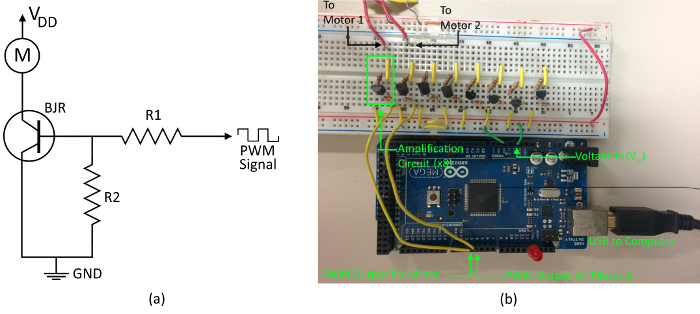一种意志的运动反应的及时性和准确性,以振动触觉刺激评价方法
Summary
本文介绍用于施加振动触觉刺激对人参与者的大腿,并测量参与者的用于刺激的位置和频率的不同组合意志响应的精度和反应时间的技术。
Abstract
Artificial sensory feedback (ASF) systems can be used to compensate for lost proprioception in individuals with lower-limb impairments. Effective design of these ASF systems requires an in-depth understanding of how the parameters of specific feedback mechanism affect user perception and reaction to stimuli. This article presents a method for applying vibrotactile stimuli to human participants and measuring their response. Rotating mass vibratory motors are placed at pre-defined locations on the participant’s thigh, and controlled through custom hardware and software. The speed and accuracy of participants’ volitional responses to vibrotactile stimuli are measured for researcher-specified combinations of motor placement and vibration frequency. While the protocol described here uses push-buttons to collect a simple binary response to the vibrotactile stimuli, the technique can be extended to other response mechanisms using inertial measurement units or pressure sensors to measure joint angle and weight bearing ratios, respectively. Similarly, the application of vibrotactile stimuli can be explored for body segments other than the thigh.
Introduction
人工感觉反馈(ASF)可以被定义为提供实时生物信息对个人,往往补偿受损本体或其他感官机构的做法。 ASF已经受伤或残疾人康复领域长期被用来帮助身体机能和运动1方面恢复– 3,允许个人控制曾经是自主神经系统4的无意识反应的物理过程。 ASF,生物力学生物反馈的子类,用外部传感器来测量与平衡或步态运动学参数,并通过某种应用的刺激传达这一信息到个人。一种日益流行的方法的生物力学反馈采用小振动马达,或病理因素,放置在身体的不同部位,以提供空间以及时间上的反馈。以前的文献已经呈现promising结果支持的应用程序与下肢截肢,前庭障碍的人使用振动触觉反馈,和老化有关的平衡5的损失– 9。
控制一个人的感知和响应特定的刺激机制的深入理解是必要的通知有效实施针对不同的应用ASF系统。为振动触觉的反馈,这些机制之间主要是本体和感觉运动响应,特别是对施加振动用户的灵敏度和执行所需的反应所需的时间。通过振动刺激传达任何感觉信息必须被编码为振动频率的特定组合,幅度,位置和序列。因此,震动触觉ASF系统的设计应该选择的参数组合,以最大限度地刺激用户的感知和解释,如还有的及时性和所得到的马达响应的准确性。该协议的目的是提供一种从其中计算的响应时间和响应精度的各种振动刺激通知ASF系统设计为具有不同的感官受损人群使用的平台。
此处所描述的方法建立在以前的研究探索的触觉和震动触觉反馈3,5,6-人类感知,并用于沿两个以前的研究-10,11-用途被开发。后两种研究采用该协议来检查在下肢截肢的准确性和用户响应及时振动频率和位置的影响,显示出这两个参数显著影响结果的措施,而且有高度的响应精度的可实现。这些结果可以被用于通知病理因素的理想放置在今后的研究和振动触觉的ASF系统的临床应用。其他最近的工作由Crea 等人的12检查用户灵敏度行走期间施加到大腿中的振动模式的变化,使用口头响应来表示感知的改变振动模式,而不是电动机的响应。虽然这些口头响应可以被用于测量检测精度,他们不考虑错误和延迟可能存在在电动机控制过程。
用于以下实验的主要设置包括许多个连接到脉冲宽度调制的微控制器板的输出管脚振动马达中的。该板,反过来,通过通用串行总线(USB)连接到一台计算机上运行市售系统设计软件控制。电机需要额外的放大电路,以确保足够的电压和电流在很宽范围的振动频率的供给。一个例子放大器电路示于图1。的双极型结型晶体管(BJR)在图中可以用小的金属氧化物半导体场效应晶体管(MOSFET)为更有效的操作和更小的尺寸来代替。类似地,整个放大电路可以由一个关闭的,现成的触觉电机驱动器被替换,以提供额外的控制和减小的尺寸。每个电机都需要自己的电路,和使用本文中列出的设备,最多十个马达可以由单个微板来控制。

图1.电机配线。(A)中的放大电路,用于单个振动电机被示出。各电动机需要一个单独的电路和必须连接到微控制器上的一个独特的PWM输出端口。与V DD这里表示由微控制器板提供的3.3伏电源,并且当零电压是应用R2用作下拉电阻,以确保该晶体管开关的电阻保持打开撒了谎。 (B)的两个电机的物理线路的一个例子。尽管示出了八个单独放大电路,只有两个被连接到振动电机。在这个协议中,R1 = 4.7kΩ和R2 = 100kΩ的。 请点击此处查看该图的放大版本。
Protocol
Representative Results
Discussion
该协议的目的是提供一种用于在振动触觉的ASF应用评估刺激参数提供框架。具体地讲,它检查振动的频率,振幅,位置和序列的用户感觉运动响应的影响。这个框架可以在建立和扩展,其中包含另外的或可选择的类型可能更临床相关,如弯曲的联合,或从一条腿移重量到另一个用户应答。这些类型的变化将需要稍微不同的硬件配置,即置换设备的按钮的如惯性测量单元(IMU产品)或压力传感器,?…
Disclosures
The authors have nothing to disclose.
Acknowledgements
This protocol was developed for research supported by the Natural Sciences and Engineering Research Council of Canada (grant RGPIN 401963).
Materials
| Vibrating Pager Motors | Precision Microdrives | Model 310-101 | Coin eccentric rotating mass motors. As many as necessary to test all locations and interactions of interest |
| Tri-axis Accelerometer | Dimension Engineering | ADXL 335 | Advanced analog accelerometer. 500Hz bandwidth, 3.5-15V input. Designed for motion, tilt, and slope measurement, as well as vibration and shock sensing |
| Arduino Uno | Arduino | DEV-11021 | Microcontroller board for communicating with the tri-axis accelerometer |
| Arduion Mega 2560 | Arduino | DEV-11061 | Microcontroller board for interfacing with the vibration motors. |
| LabVIEW | National Instruments | Data acquisition software used to control motors and display accelerometer signals | |
| Arduino IDE Software | Arduino | v. 1.6.5 | |
| Push-Button | Bridges | Buddy Button | Wired switch featuring a 2.5in/6.35cm activation surface that provides an auditory click and tactile feedback. |
| Optional: | |||
| Dedicated haptic motor driver | Texas Instruments | DRV2605L | Can be used to replace the entire amplification circuit described in Step 1. |
| Flexible wearable goniometer | Biometrics Ltd. | SG110 | Twin axis flexible goniometers to measure angles in up to two planes of movement that can be used in lieu of the push button to measure joint movement in response to stimuli. www.biometricsltd.com/gonio.htm |
References
- Tate, J. J., Milner, C. E. Real-time kinematic, temporospatial, and kinetic biofeedback during gait retraining in patients: a systematic review. Phys. Ther. 90 (8), 1123-1134 (2010).
- Onate, J. A., Guskiewicz, K. M., Sullivan, R. J. Augmented feedback reduces jump landing forces. J. Orthop. Sports Phys. Ther. 31 (9), 511-517 (2001).
- Cholewiak, R. W. The perception of tactile distance: Influences of body site, space, and time. Perception. 28 (7), 851-875 (1999).
- Zhang, Z., Wu, H., Wang, W., Wang, B. A smartphone based respiratory biofeedback system. Proc. 2010 3rd Int. Conf. Biomed. Eng. Informatics. 2, 717-720 (2010).
- Wentink, E. C., Mulder, A., Rietman, J. S., Veltink, P. H. Vibrotactile stimulation of the upper leg: Effects of location, stimulation method and habituation. Proc. Annu. Int. Conf. IEEE Eng. Med. Biol. Soc. , 1668-1671 (2011).
- Rusaw, D., Hagberg, K., Nolan, L., Ramstrand, N. Can vibratory feedback be used to improve postural stability in persons with transtibial limb loss?. J. Rehabil. Res. Dev. 49 (8), 1239-1254 (2012).
- Goodworth, A. D., Wall, C., Peterka, R. J. Influence of feedback parameters on performance of a vibrotactile balance prosthesis. IEEE Trans. Neural Syst. Rehabil. Eng. 17 (4), 397-408 (2009).
- Asseman, F., Bronstein, A. M., Gresty, M. A. Using vibrotactile feedback of instability to trigger a forward compensatory stepping response. J. Neurol. 254 (11), 1555-1561 (2007).
- Fan, R. E., Culjat, M. O., et al. A haptic feedback system for lower-limb prostheses. IEEE Trans. Neural Syst. Rehabil. Eng. 16 (3), 270-277 (2008).
- Sharma, A., Torres-moreno, R., Zabjek, K., Andrysek, J. Toward an artificial sensory feedback system for prosthetic mobility rehabilitation: Examination of sensorimotor responses. J. Rehabil. Res. Dev. 51 (6), 416-425 (2014).
- Sharma, A., Leineweber, M. J., Andrysek, J. The effects of cognitive load and prosthetic liner on volitional response times to vibrotactile feedback. J. Rehabil. Res. Dev. , (2016).
- Crea, S., Cipriani, C., Donati, M., Carrozza, M. C., Vitiello, N. Providing Time-Discrete Gait Information by Wearable Feedback Apparatus for Lower-Limb Amputees: Usability and Functional Validation. IEEE Trans. Neural Syst. Rehabil. Eng. 23 (2), 250-257 (2015).
- Bolanowski, S. J., Gescheider, G. A., Verrillo, R. T., Checkosky, C. M. Four channels mediate the mechanical aspects of touch. J. Acoust. Soc. Am. 84 (5), 1680-1694 (1988).
- Giggins, O. M., Persson, U. M., Caulfield, B. Biofeedback in rehabilitation. J. Neuroeng. Rehabil. 10 (1), 60 (2013).
- Shull, P. B., Jirattigalachote, W., Hunt, M. A., Cutkosky, M. R., Delp, S. L. Quantified self and human movement: A review on the clinical impact of wearable sensing and feedback for gait analysis and intervention. Gait Posture. 40 (1), 11-19 (2014).
- Goodworth, A. D., Peterka, R. J. Sensorimotor integration for multisegmental frontal plane balance control in humans. J. Neurophysiol. 107 (1), 12-28 (2012).

